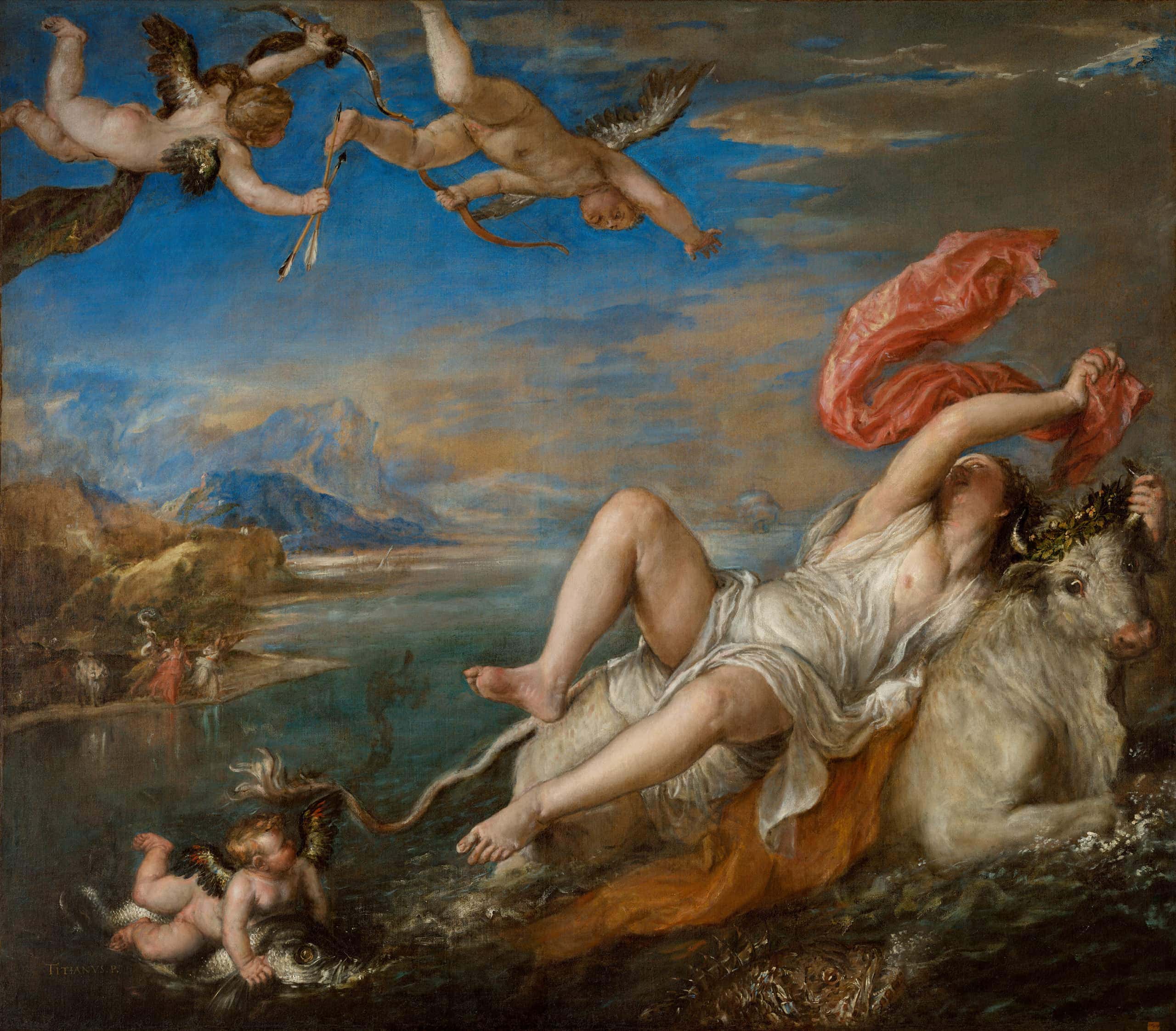

Titian, Diana and Callisto, 1556-9, oil on canvas , 187 × 204.5 cm, © The National Gallery London / The National Galleries of Scotland
For our most eternal concerns, our oldest stories. Passed from generation to generation, in oral traditions and then committed to writing by Ovid, Metamorphoses has lost none of its primal power in translation to paint and canvas; light, shadow, and sweat. Beneath Titian’s inimitable hand, characters from ancient myth are brought into heaving high definition. Love, Desire and Death – what more could you ask?
Seven canvases, filled over years and to order for King Phillip II of Spain, hang together in the (closed) National Gallery. It’s a full-house reunion that Titian himself would never have seen: there’s Danaë, sprawled nude on a tousled bed; Actaeon, falling to divine retribution and torn to pieces by his own hounds; Venus, clutching her beloved Adonis as he wrestles to free himself and break her heart. Oh yeah, and everyone’s naked.
Beneath Titian’s inimitable hand, characters from ancient myth are brought into heaving high definition
While a working Renaissance artist’s usual scope began and ended with biblical scenes, the classics were a long-established excuse to dabble in more diverse subject matter. Although Christian art overflowed with images of violence and abject nakedness, those themes were circumscribed by doctrine. Beyond depictions of, say, the crucifixion, or saints’ martyrdoms, flesh was as strictly off limits in art as it was in real life.
There are only so many altarpieces one can stomach: bring on the Greeks, and Ovid’s Metamorphoses. Terming his theme ‘poesie’, as in ‘poetry’, Titian erects different altars altogether. His canvases, idols for humanity’s deepest and darkest currents; devotional offerings to gods which make an infant of Christianity’s. And the Helenic pantheon are a curious bunch, to say the least.

Titian, Venus and Adonis, about 1553-4, oil on canvas, 186 × 207 cm, Museo Nacional del Prado, Madrid, © Photographic Archive Museo Nacional del Prado, Madrid

Titian, Diana and Actaeon, 1556-9, oil on canvas 184.5 x 202.2 cm, © The National Gallery London / The National Galleries of Scotland
While Christianity conceives divinity as synonymous with moral perfection, the characters populating Titian’s canvases are defined by their fallibility. Think human – lustful, tempestuous, cruel – but immortal, and decidedly interventionist. In Greek myth, gods pop up among people every five minutes; siring children, ‘ravishing’ maidens, enacting revenge and transforming humans into animals more often than seems fair.
Jupiter and Diana are especial favourites, and bathing – more nudity, vulnerability – is the catalyst for many of Titian’s situational subjects. Whether it’s Actaeon interrupting Diana mid-wash, or Callisto’s pregnancy being revealed to Diana and her maidens after being raped by Jupiter (not pictured, Jupiter’s wife Juno turning her into a bear – more’s the pity, because I bet that would look great), the exhibition’s titular love, death and desire fall in step with a predictably improbable blueprint.
Titian treats the fables, gods versus mortals and action versus consequence, with the grounded humanness they demand. After all, we came up with these stories, once upon a time
Titian treats the fables, gods versus mortals and action versus consequence, with the grounded humanness they demand. After all, we came up with these stories, once upon a time – on some level, they dramatise essential truths about every one of us. Not least Titian’s subjects; while the context in which these characters find themselves on canvas is fictional, eternal, the women he worked into them were right in front of him.
Painting from life, in 16th-century Venice, the sex trade was Titian’s main source of female models. The immediacy and embodiedness of Europa, flailing as she’s carried off by Jupiter in the form of a bull, pulls myth and its morals into unflinching three dimensionality. Danaë’s softness, and characterful chin tilt, betray her model’s living-breathing-bleeding corporeality.
Array
Titian, The Death of Actaeon, about 1559-75, oil on canvas, 178.8 x 197.8 cm, © The National Gallery, London
Titian brings bodies – desired and desirous, vulnerable and perishable – to bear on the West’s most enduring myths and values. For stories which deal so explicitly with women’s bodies and the consequences of having one, it seems radical to write Titian’s contemporaneous cohort so large across the devout King’s mail-order masterpieces. Radical, and only right.
Love, in the wild heartbreak of Venus; Danaë, lounging coyly as Jupiter rains down gold upon her. Melting into desire, that troublesome twitch propels peeping Actaeon to Diana’s toilette. Jupiter spirits Europa away, and it’s one short jump to the finality of the exhibition’s last subject. One could reasonably term the poesie works a series of portraits: of specific people, and of us all.
Titian brings bodies – desired and desirous, vulnerable and perishable – to bear on the West’s most enduring myths and values
Provocative as ever in 2020, depicting scene upon scene of rape and retribution, we can only imagine the cognitive dissonance of the pious monarch who commissioned Titian’s series piece by piece. Circling the female body as satellite, call it sex, savagery and – that’s it.
That’s all there is to say, which is to say ‘everything’, and no one says it like Titian.


